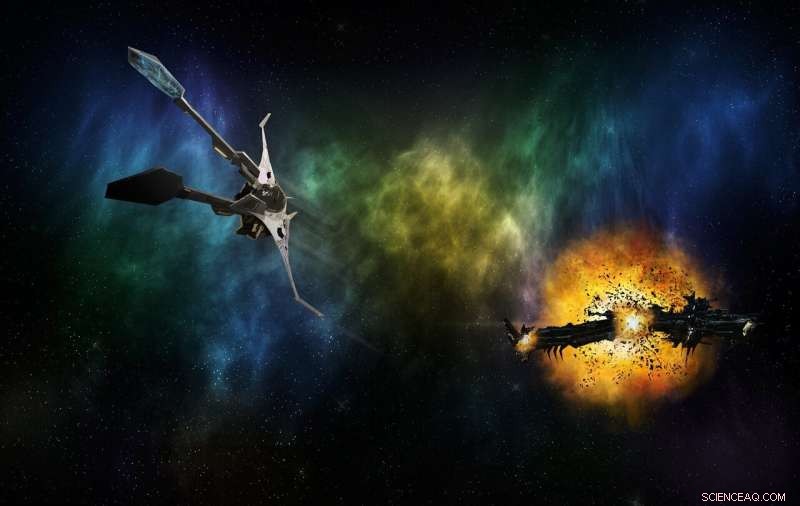
Crédit :Pixabay/CC0 domaine public
Les films spatiaux de science-fiction peuvent faire un mauvais travail pour éduquer les gens sur l'espace. Dans les films, des pilotes de pointe dirigent leurs vaisseaux spatiaux en duel à travers l'espace comme s'ils volaient dans une atmosphère. Ils s'inclinent, tournent et effectuent des boucles et des tonneaux, peut-être lancer un rapide tour Immelman, comme s'ils étaient soumis à la gravité terrestre. Est-ce réaliste ?
Non.
En réalité, une bataille spatiale est susceptible d'être très différente. Avec une présence croissante dans l'espace, et le potentiel de conflits futurs, est-il temps de réfléchir à ce à quoi ressemblerait une véritable bataille spatiale ?
L'organisation à but non lucratif Aerospace Corporation pense qu'il est temps de réfléchir à ce à quoi ressemblerait une véritable bataille spatiale. Le Dr Rebecca Reesman du Centre for Space Policy and Strategy de l'Aerospace Corporation et son collègue James R. Wilson ont écrit un article sur le thème des batailles spatiales, intitulé "The Physics of Space War:How Orbital Dynamics Constrain Space-to-Space Engagements."
Si les affaires humaines passées indiquent l'avenir, alors la militarisation de l'espace se poursuivra. C'est en dépit des discussions sur le maintien de l'espace paisible, et malgré les traités qui disent la même chose. Il est donc important qu'à mesure que de plus en plus de nations accroissent leur présence dans l'espace, et comme une compétition pour les ressources commence à causer des problèmes, que la conversation autour du conflit spatial prenne une tournure réaliste.
C'est le cas que font les auteurs dans l'introduction de leur article. "Alors que les États-Unis et le monde discutent de la possibilité d'un conflit s'étendant dans l'espace, il est important d'avoir une compréhension générale de ce qui est physiquement possible et pratique. Scènes de Star Wars, les livres et les émissions de télévision dépeignent un monde très différent de ce que nous sommes susceptibles de voir dans les 50 prochaines années, si jamais, vu les lois de la physique."
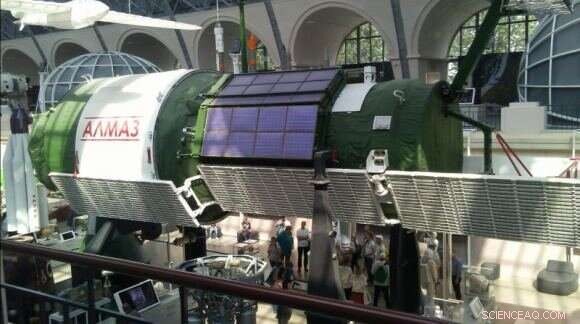
Une station spatiale soviétique Almaz en équipage au Centre de cosmonautique et d'aviation de Moscou. La Russie a conçu plusieurs types de satellites militaires et de stations spatiales, certains armés d'une mitrailleuse, avant d'abandonner l'idée car trop chère. Crédit :Par Pulux11 – Travail personnel, CC BY-SA 4.0
Il n'y a encore jamais eu de bataille dans l'espace. Mais il y a eu des activités d'essais d'armes. La Chine travaille sur des armes anti-satellites et a testé un missile anti-satellite. L'Inde aussi. La Russie travaille également sur les capacités antisatellites, et les États-Unis font de même. Les États-Unis ont en fait détruit l'un de leurs propres satellites avec un missile en 1985.
Ce n'est probablement que la pointe de l'iceberg en ce qui concerne les futurs conflits dans l'espace. Aucune de ces activités antisatellites n'impliquait des personnes voyageant dans des engins spatiaux, et il n'y aura peut-être jamais besoin d'engins spatiaux militaires avec équipage, selon le papier. "Les engagements espace-espace dans un conflit moderne seraient menés uniquement avec des véhicules sans équipage contrôlés par des opérateurs au sol et fortement contraints par les limites que la physique impose aux mouvements dans l'espace."
Aux premiers jours de l'ère spatiale, alors que la guerre froide faisait encore rage, les superpuissances imaginaient que les conflits dans l'espace seraient en grande partie une extension des conflits terrestres. Les Soviétiques ont même conçu des stations spatiales armées d'une mitrailleuse pour se défendre contre les attaques des astronautes américains. Les États-Unis ont travaillé sur des idées similaires.
Mais les avancées technologiques ont fait que ces efforts ont été abandonnés au profit de satellites sans équipage. "Finalement, les deux programmes ont échoué. Au lieu, les améliorations de la technologie et de la transmission de données - les mêmes développements qui sous-tendent en fin de compte notre vie connectée moderne - ont rendu possibles des satellites qui remplissent les mêmes fonctions militaires envisagées pour les programmes en équipage précédents. l'espace est dominé par les satellites, avec seulement l'ISS hébergeant des humains.
Ce sera l'avenir, selon le papier. Pour les 50 prochaines années environ, tout conflit dans l'espace entraînera des attaques contre des satellites. Mais tout ne sera pas une attaque pure et simple. Les auteurs décrivent quatre objectifs dans une attaque spatiale :
Les batailles spatiales seront probablement entre satellites, et le ravitaillement ne sera pas une option. Dans cette image, un F-16 fait le plein d'un KC-135 Stratotanker. Crédit :Par l'US Air Force 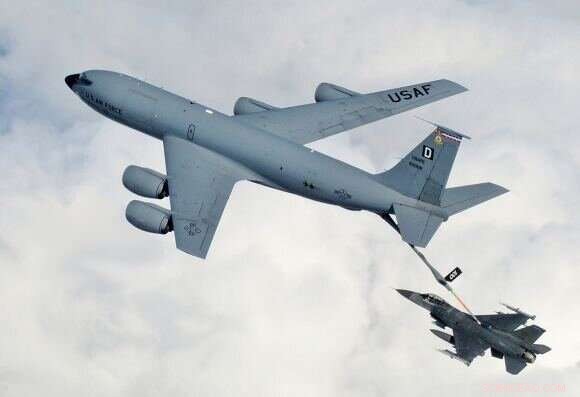
Les satellites se déplacent de manière très prévisible. Ils se déplacent rapidement, mais il est relativement facile de prédire leur position future et de les intercepter, dans de nombreux cas. Certains satellites peuvent changer leur hauteur orbitale, mais ils n'ont aucune réelle maniabilité et presque aucun moyen d'éviter une attaque.
"Pour décrire comment la physique limiterait les engagements espace-espace, cet article décrit cinq concepts clés :les satellites se déplacent rapidement, les satellites se déplacent de manière prévisible, l'espace est grand, le timing est tout, et les satellites manœuvrent lentement."
Le vol dans l'atmosphère terrestre n'est pas vraiment simple, mais c'est assez intuitif. Mais dans l'espace, c'est complètement différent et ne s'appelle pas exactement vol. Sans atmosphère et faible gravité, les choses sont très différentes. "Les mouvements dans l'espace sont contre-intuitifs pour ceux qui sont habitués à voler dans l'atmosphère terrestre et à la possibilité de faire le plein, " écrivent les auteurs.
"Les engagements espace-espace seraient délibérés et se dérouleraient probablement lentement car l'espace est grand et les engins spatiaux ne peuvent échapper à leurs trajectoires prévisibles qu'avec de grands efforts. De plus, les attaques contre les ressources spatiales exigeraient de la précision car les engins spatiaux et même les armes au sol ne peuvent engager des cibles dans l'espace qu'après que des calculs complexes aient été déterminés dans un domaine hautement technique. en attente de brouiller et de lancer rapidement. Au lieu, une bataille spatiale impliquant des satellites est plus un exercice mathématique.
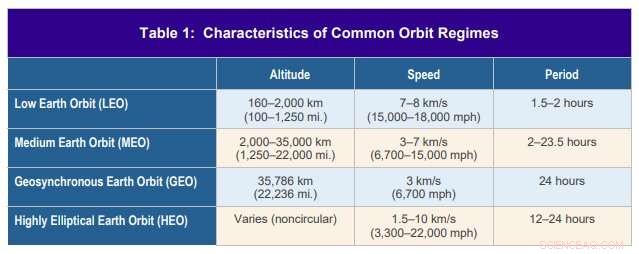
Satellite orbits are predictable and don’t depend on the mass of the satellite. Credit:Reesman and Wilson 2020.
"This is true because physics puts constraints on what happens in space. Only by mastering these constraints can other questions such as how to fight and, le plus important, when and why to fight a war in space, be explored, " they write.
A satellite's orbit is predictable because of the relationship between speed, altitude and the orbit's shape. At lower altitudes, satellites can experience atmospheric drag. Aussi, the Earth isn't a perfect sphere. But those factors can be accounted for in an attack. "To deviate from their prescribed orbit, satellites must use an engine to maneuver. This contrasts with airplanes, which mostly use air to change direction; the vacuum of space offers no such option, " they write.
The sheer volume of space is also a factor in a space battle. "The volume of space between LEO and GEO is about 200 trillion cubic kilometers (50 trillion cubic miles). That is 190 times bigger than the volume of Earth."
So tracking satellites accurately in that volume of space will be a continuous challenge, since some will be designed to be undetected. But that's not impossible; satellites are regularly tracked. And since they're not very maneuverable, once a satellite's orbit is detected, monitors can keep track of its trajectory.
The sheer volume of space also means that most space battles would be very short-lived. There won't be any dogfights. "Space is big, which means that a space-to-space engagement is not going to be both intense and long. It can only be one or the other:either a short, intense use of a lot of Delta V for big effect or long, deliberate use of Delta V for smaller or persistent effects."
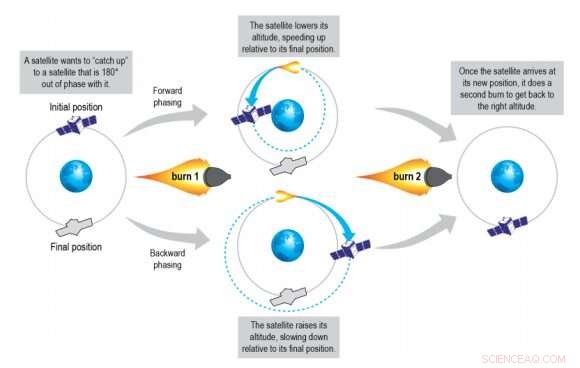
Satellites change their position in their orbit with phasing maneuvers. Any time a satellite raises its orbit, it slows down and appears to be moving backward in relation to its prior orbit and altitude. This is how a satellite can “catch up” to another satellite. Credit:Reesman and Wilson 2020
Delta V is a change in velocity, and that requires fuel or propellant. But most satellites don't have the capability to change their velocity, and the few that might are severely fuel-limited.
"Operators of an attack satellite may spend weeks moving a satellite into an attack position during which conditions may have changed that alter the need for or the objective of the attack." And if the defending satellite is able to only slightly change its own path in response to an attack, then the attacking satellite may not have the capability or the fuel to change its own path to intercept it.
The authors also point out that timing is everything. Even if an attacking satellite can orient itself into the same orbital path as its target, there's still no guarantee of proximity.
"The nature of conflict often requires two competing weapons systems to get close to one another, " the report says. The authors use the example of an aircraft carrier needing to get close to its target, and another of jet fighters that also need to be close to each other. The same thing is true of satellites in space.
"Getting two satellites to the same altitude and the same plane is straightforward (though time and ?V consuming), but that does not mean they are yet in the same spot. The phasing—current location along the orbital trajectory—of the two satellites must also be the same. Since speed and altitude are connected, getting two satellites in the same spot is not intuitive." Instead, it takes perfect timing and meticulous preparation.
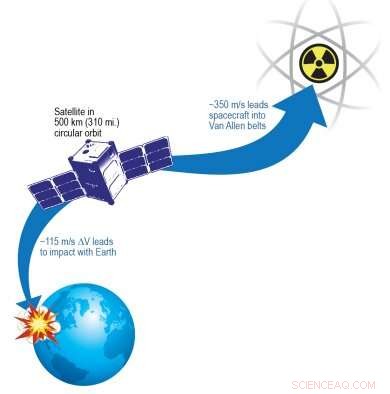
If a satellite performs a forward phasing maneuver with a first burn of 115 m/s or more of ?V, it will reenter Earth’s atmosphere and burn up. De la même manière, if the satellite performs a backward phasing maneuver with a first burn of 350 m/s or more of ?V, it will experience high radiation in the Van Allen belts. These two facts create natural bounds for how quickly a satellite can maneuver in LEO (500 km or 310 mi.). Credit:Reesman and Wilson 2020
The authors also discuss another method of approaching a target called "plane matching, " A satellite maneuvers itself so that its orbital plane is aligned with a target. That has the advantage of allowing the attacker to dictate the time of the engagement. "By not initiating threatening maneuvers immediately, an attacker may try to seem harmless while waiting for an optimal time to attack, " the authors explain.
But none of these maneuvers happen quickly. "The physics of space dictate that kinetic space-to-space engagements be deliberate with satellites maneuvering for days, if not weeks or months, beforehand to get into position to have meaningful operational effects, " they write. But it can still be done.
And once the interception has been set up, "…many opportunities can arise to maneuver close enough to engage a target quickly."
There are natural limits to how maneuvering satellites in LEO can do. D'une part, some phasing maneuvers can send the satellite into the Earth's atmosphere where it will be burned up. De l'autre, it could be sent too far away from LEO, into the Van Allen Belts. So there are constraints on a satellite's maneuverability.
Satellites in geostationary orbits maintain the same relative position over Earth, so some of the mechanics of attacking and defending are different. Mais globalement, the same constraints are still in place. It takes time and energy to maneuver in space, regardless of the type of orbit.
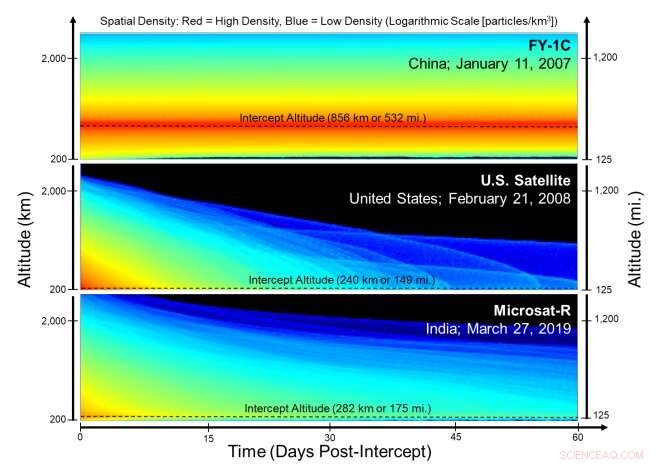
The density of debris is compared at different altitudes as a function of time after the ASAT intercepted (made contact with and destroyed) the target satellite. The Chinese test happened at a much higher altitude (856 km or 532 mi.) than the other two, creating long-lasting debris. Credit:Reesman and Wilson, 2020
But orbital and maneuverability considerations are only a part of what the report addresses.
The authors go on to discuss the types of attacks that can take place. Collisions, projectiles, and electronic jamming or disruption are covered in the paper. Each type has its own considerations and preparations.
But the authors also discuss the aftermath of some successful attacks:complications arising from debris. Additional debris could end up damaging other unintentional targets, like the attacker's own satellites or those of a neutral nation. There have been three successful anti-satellite attacks:one by China, one by the U.S., et l'Inde. The authors prepared a graphic to show the debris from each one.
The debris cloud from an attack is denser immediately after the attack and spreads out quickly. Even though debris density is lowered quickly, the debris spreads out over a larger area and is still hazardous.
The paper is a clear presentation of all of the difficulties with space battles and how much different they would be compared to air-to-air battles. But some other considerations that are still important are outside its scope.
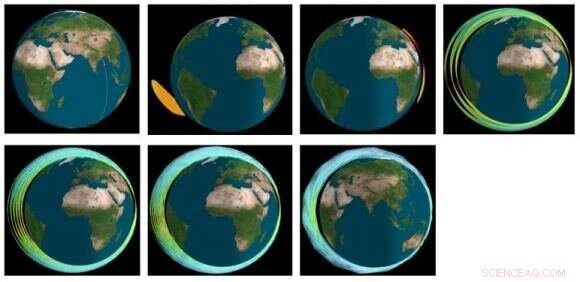
This image shows the debris cloud from the Indian ASAT in 2019. The panels show the cloud at 5 min., 45 min., 90 minutes, 1 day, 2 days, 3 days, and 6 days after the attack. Credit:Reesman and Wilson 2020
What happens when one nation deduces that their satellites are about to be attacked? They won't sit on their thumbs. They'll likely denounce, threaten, and even retaliate here on Earth. A space attack could end up being a flashpoint for another terrestrial war.
There could end up being an arms race in space, where nations compete to outspend each other on space weaponry and other technology. That's a huge strain on resources for a world that should be focused on meeting the challenge of climate change.
Et, where does it all end? War in orbit? War on the moon? War on Mars? When will humanity figure it out and just stop?
Un jour, peut être, there'll be a final war before we give it all up. But that won't likely be in the next 50 years.
And if there is a war in the next 50 years or so, it may involve satellites, and it may look a lot like how the authors of this report have laid it out:slow, calculated, et délibéré.